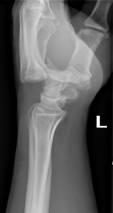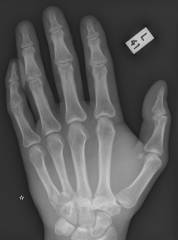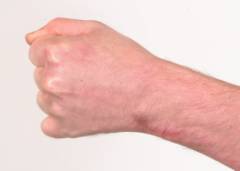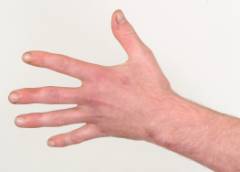|
Abstract:
Multiple carpometacarpal joint dislocations
are rare, occurring most frequently in high energy trauma,
especially road traffic accidents involving motor-cyclists. They
are usually associated with fractures of the metacarpal or
carpal bones (usually the little finger metacarpal), and usually
require open reduction and internal fixation to achieve good
long term function.
We report a case of a dislocation of the index, middle and ring
finger carpometacarpal joints as well as a fracture dislocation
of the little finger carpometacarpal joint, following a
motorcycle accident. This was treated with prompt closed
reduction under general anaesthetic (without the use of
Kirschner wire fixation), and a period of close observation with
specialised hand therapists. The patient went on to have a good
functional outcome.
This case shows that it is possible to manage these relatively
rare injuries conservatively with prompt reduction and casting,
coupled with intense physiotherapy and close clinical
observation.
J.Orthopaedics 2009;6(1)e1
Keywords:
Carpometacarpal dislocation; trauma
Introduction:
Multiple carpometacarpal (CMC) joint dislocations are
rare. They account for less than 1% of hand injuries, and occur
most frequently associated with fractures of the metacarpal or
carpal bones (usually the little finger metacarpal) (1,2,6,10).
Previous reports in the literature suggest that these injuries
are sustained by a variety of different mechanisms, including
crush injuries and falls, but occur most commonly following
motorcycle accidents, classically as a result of firmly gripping
the handlebars prior to impact (7).
Case
Report:
A
right handed 33-year old graphics engineer presented to the
Emergency Department with an injury to the left hand following a
collision with a car whilst riding his motorcycle. He had
stopped abruptly from a speed of thirty-five miles per hour
whilst holding the handlebars. He had been wearing full
protective clothing including reinforced gloves (which were
mildly damaged as a result of the accident).
He had previously sustained a laceration to his hand,
transecting his left extensor digiti minimi tendon, which was
repaired and from which he had made a full recovery.
On arrival in the Emergency Department he was assessed according
to the ATLS protocol, and a closed injury to the left hand was
identified, along with some other superficial abrasions.
Further examination of the hand revealed significant
swelling and deformity around the CMC area, with bony
tenderness. He was unable to flex or extend his fingers, and all
other movements of the hand and wrist were limited by pain.
There was no neurovascular compromise.
Posteroanterior radiographs showed shortening of the ulna
metacarpals and a fracture of the proximal little finger
metacarpal. Lateral radiographs showed dorsal dislocation of the
CMC joints of the index, long and ring fingers, with dorsal
displacement of the metacarpals, and a comminuted intrarticular
fracture dislocation of the base of the little finger
metacarpal, with dorsal displacement.
 |
 |
| Fig
1 – Initial lateral and postero-anterior radiographs
|
The
patient was placed in a dorsal backslab and the limb was
elevated in a Bradford sling before being taken to theatre.
Under a general anaesthetic the CMC joints and the fracture of
the little finger metacarpal were reduced by manipulation. The
stability of the joints and the fracture were found to be
satisfactory under clinical and fluoroscopic assessment, thus
requiring no further stabilisation or fixation. He was placed in
a dorsal backslab in neutral alignment and observed. He was
followed up at six days and six weeks the plaster was removed
revealing an acceptable range of movement, and repeat
radiographs showed good position. At this point, the patient was
commenced on a regime of hand physiotherapy, and was warned that
there was a chance of re-dislocation and requiring subsequent
re-manipulation and the possibility of internal fixation.
Specialised hand therapy continued for three months. There was a
small residual rotational deformity of the little finger
following the injury, but his range of movement at this stage is
excellent, with an unaffected level of function.
 |
 |
| Fig
2 – Post rehabilitation photographs showing excellent range of
movement and grip
|
Discussion :
A
significant force is required to achieve dislocation of the CMC
joints (4,9). Several cases are described in the literature
following motorcycle accidents. We concur with Shih et al (12)
that the most likely cause of the injury is a large deceleration
force communicating longitudinally and dorsally through the
metacarpals via the motorcycle handlebars, resulting in
dislocation of the CMC joints. Dorsal dislocation is more common
than volar dislocation, with the direction of dislocation
following the direction of the force applied (11).
The management of CMC dislocations remains controversial,
although it is well accepted that the initial treatment involves
closed reduction and application of plaster cast (13), however
some cases require reduction and internal fixation (8).
Prokuski et al, 2001 (14) have published the largest
series of this injury complex, supporting prompt open reduction
and internal fixation, as there is often difficulty achieving a
stable closed reduction due to oedema, interposed soft tissue
and bone fragments (from fractures of the metacarpal or carpal
bones) or ligament damage. Open Reduction and Internal Fixation
is best achieved via a dorsal approach, with good fixation of
the middle finger metacarpal base being crucial to the all round
stability of the reduction (5,9).
Close observation is essential after reduction has been
achieved, to ensure that anatomical reduction is maintained,
thus reducing the incidence of functional complications such as
grasp weakness, muscle imbalance and arthritis (3).
This case confirms that CMC joint dislocations are high energy
injuries strongly associated with motorcycle accidents (7). It
is possible to achieve stability with early reduction and
without the need for open reduction and internal fixation, nor
the need for Kirschner wire fixation, and that function is
optimised with intensive physiotherapy under close clinical
supervision.
CMC joint dislocations are often difficult to detect clinically.
However, marked pain and swelling in this area should give a
high index of suspicion. This coupled with their high energy
nature and subsequent association with other more
life-threatening injuries makes a thorough secondary survey
crucial, and reinforces the importance of true lateral
radiographs in diagnosis.
Reference :
-
Bergfield TG, Dupuy TE, Aulicino PL (1985) Fracture
dislocations of all five carpometacarpal joints – a case
report. J Hand Surg 10A: 76-78
-
Dobyns JH, Linscheid RL, Cooney WP (1983) Fractures and
dislocations of the wrist and hand, then and now. J Hand
Surg 8A:687-690
-
Glickel SZ, Barron OA, Eaton RG (1998) Dislocations and
ligament injuries in the digits In: Green DP (ed) Operative
hand surgery, 4th edn. Churchill Livingstone, New York,
pp772-808
-
Gunther SF (1984) The carpometacarpal joints. Orthop Clin
North Am. 15:259-277
-
Hartwig RH, Louis DS (1979) Multiple carpometacarpal
dislocations: a review of four cases. J Bone and Joint Surg
61A 906-908
-
Hsu
JD, Curtis RM (1970) Carpometacarpal dislocations on the
ulnar side of the hand. J Bone Joint Surg 52A:927-930
-
Kneife F (2002) Simultaneous dislocations of the five
carpometacarpal joints Injury Nov;33(9):846
-
Kumar R, Malhortra R (2001) Divergent fracture dislocation
of the second carpometacarpal joint and the three ulnar
carpometacarpal joints. J Hand Surg 26A: 123-129
-
Lawlis JF, Gunther SF (1991) Carpometacarpal dislocations:
Long term follow up. J Bone Joint Surg 73A: 52-58
-
Mueller JJ (1986) Carpometacarpal dislocation: report of
five cases and review of the literature. J Hand Surg (Am)
11:184-8
-
Pankaj A, Malhotra R, Bhan S (2005) Isolated dislocation of
the four ulnar carpometacarpal joints. Arch Orthop Trauma
Surg 125: 541 – 544
-
Shih
KS, Tsai WF, Wu CJ, Mudgal C (2006) Simultaneous dislocation
of the Carpometacarpal and Metacaprophalageal joints of the
thumb in a motorcyclist. J Formos Med Assoc Vol 105, No8
-
Watt
N, Hooper G. Dislocation of the trapezio-metacarpal joint.
(1987) J Hand Surg 12B 242-5
-
Prokuski LJ, Eglseder WA Jr. Concurrent
dorsal dislocations and fracture-dislocations of the index,
long, ring, and small (second to fifth) carpometacarpal
joints. J
Orthop Trauma. (2001) Nov;15(8):549-54.
|






